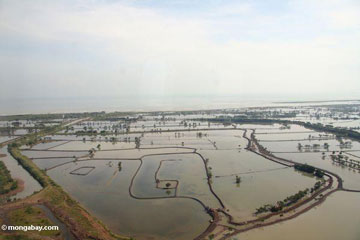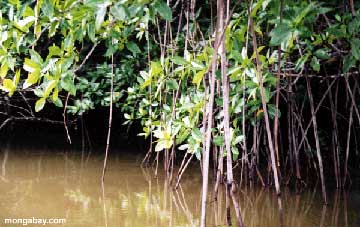Wal-Mart demand drives “greener” shrimp farms
Wal-Mart demand drives “greener” shrimp farms
mongabay.com
July 24, 2007
Wal-Mart’s demand for sustainably-produced products is driving “greener” production of shrimp in Thailand, reports the Wall Street Journal (WSJ).
Environmentalists have long complained about damages wrought by the shrimp-farming industry. Pollution from shrimp farm effuse and clearing of biologically-important mangrove forests are generally cited as top concerns.
Now mandating that its suppliers meet certain sustainability standards, Wal-Mart’s is pushing its main provider of farmed shrimp, Rubicon Resources LLC, for changes in how shrimp are cultivated in its Thai farms. The overhaul could influence shrimp production in other parts of Asia.
According to the WSJ, Rubicon is “increasing the testing and documentation of what is in its ponds, planting mangrove elsewhere to make up for the trees destroyed by its farms and standardizing treatment of the water discharged from its ponds.” The firm will also be required to eliminate the use of antibiotics and pay workers fair wages.

|
However, the regulations may prove burdensome to smaller operators, who cannot afford to pay for inspection fees mandated by the alliance. Wal-Mart will not reimburse operators for the expenses nor pay a premium for the shrimp, reports the article.
“Wal-Mart views those costs as the industry’s responsibility,” write Kris Hudson and Wilawan Watcharasakwet. Because Wal-Mart is the dominant player in the industry, accounting for 3.4 percent of the 590,299 metric tons of shrimp imported into the U.S. last year, Wal-Mart can pretty much do as it pleases.
Nevertheless, Rubicon sees Wal-Mart’s whims as an opportunity. The firm has spent more than $2 million acquiring Thai farms and improving operations to meet standards set by the Global Aquaculture Alliance, an industry group. The alliances, which counts Darden Restaurants Inc. (owner of Red Lobster) as a member, will soon unveil similar guidelines for the production of tilapia, catfish, and salmon.
Related
Mangroves more threatened than rainforests.
Destruction of mangrove forests could leave the world deprived of their important ecological services by the end of a century, warns an international team of scientists writing in the July 6th issue of the journal Science. Mangrove forests, which once covered more than 200,000 square kilometers of coastline, have been diminished by 35-86 percent in extent in locations around the world, according to the U.N. Food and Agriculture Organization, and are critically endangered or approaching extinction in 26 out of the 120 countries in which they are found. Further, mangrove forests are disappearing at a rate of 1-2 percent per year, a pace that surpasses the destruction of adjacent ecosystems, coral reefs and tropical rainforests. These losses, combined with increasing fragmentation of mangroves, reduces their viability and the quality of the services–including controlling coastal erosion, buffering against storm damage, and serving as a refuge for wildlife–they provide.
How to save the world’s oceans from overfishing.
Global fishing stocks are in trouble. After expanding from 18 millions tons in 1950 to around 94 million tons in 2000, annual world fish catch has leveled off and may even be declining. Scientists estimate that the number of large predatory fish in the oceans has fallen by 90 percent since the 1950s, while about one-quarter of the world’s fisheries are overexploited, depleted, or recovering from depletion. Unsustainable fishing practices like bottom-trawling and some forms of long-lining not only deplete targeted species, but net sea birds, turtles, and other marine life, while destroying delicate ecosystems like deep-sea reefs. About one quarter of global fish catch is tossed back overboard, dead or dying, as bycatch.
Can cattle ranchers and soy farmers save the Amazon?
John Cain Carter, a Texas rancher who moved to the the Brazilian state of Mato Grosso 11 years ago and founded what is perhaps the most innovative organization working in the Amazon, Aliança da Terra, believes the only way to save the Amazon is through the market. Carter says that by giving producers incentives to reduce their impact on the forest, the market can succeed where conservation efforts have failed. What is most remarkable about Aliança’s system is that it has the potential to be applied to any commodity anywhere in the world. That means palm oil in Borneo could be certified just as easily as sugar cane in Brazil or sheep in New Zealand. By addressing the supply chain, tracing agricultural products back to the specific fields where they were produced, the system offers perhaps the best market-based solution to combating deforestation. Combining these approaches with large-scale land conservation and scientific research offers what may be the best hope for saving the Amazon.








